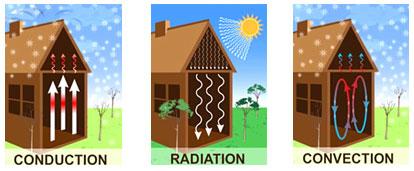
Ever wonder why your home has those persistently hot or cold rooms that seem impossible to cool down or heat up? The building science answer is Heat Transfer. Heat transfer in a home all boils down to the two laws of thermodynamics, which is an area of science that looks at the relationship between heat and other kinds of energy.
The first law of thermodynamics states:
- Energy moves from place to place
- Energy changes from one form to another
- Energy cannot be created or destroyed
The second law of thermodynamics states:
- Heat moves from warmer to cooler
- Air moves from higher pressure to lower pressure
- Moisture moves from wetter to drier
How the laws of thermodynamics apply to a home
We all know that heat moves, but does it necessarily “rise,” as we were all taught growing up? Not necessarily because heat can move in any direction. For example, if your living space is 70 degrees and your unconditioned basement is 52 degrees, the heat in your living space will move downward, since heat moves from a warmer space to a cooler space.
Heat transfer occurs in three different ways: conduction, convection and radiation.
Think of conduction in terms of your morning coffee – the steaming hot liquid is placed in a paper cup which you then hold in your hand. Without that extra cardboard sleeve, your hand will start to feel the heat pretty quickly. That is conduction: the transfer of heat between objects that are in contact.
Convection is the transfer of heat by the circulation of a liquid or gas. This type of heat transfer requires a fluid medium, such as air. To visualize this, imagine a furnace with a burner and a heat exchanger. The furnace also has an air-handler, which blows air. Because the air is cool and the flame is hot, the heat moves through the air and the warm air is pushed through the ducts and into the home.
Finally, radiation is the transfer of heat from a warm object through space to a cooler object. The two objects do not have to be touching for successful heat transfer. Radiant heat transfer is generally the culprit for discomfort in a home.
How heat transfer works in a home
Heat moves around your home by conduction, convection and radiation.
On a cold day:
- Convection causes warm air in your living space to rise.
- That air moves by conduction through the ceiling to the attic floor. If the house is leaky, the heat will also move into the attic space by convection.
- The heat from the attic floor radiates to the roof.
- The heat conducts through the roof assembly and out.
On a hot day:
- Heat from the sun radiates on to the roof.
- The heat conducts through the roof assembly and radiates from the roof to the attic floor.
- The heat conducts from the attic floor to the ceiling below.
- The heat radiates to cooler surfaces in your living space.
It is important to know how heat moves within a home so you can understand what it means to have a home with either a heat loss or a heat gain issue. If you find that the level of snow on your roof is uneven in the winter (bare spots in some places and piled up in others) then you can bet your home is losing heat through the attic. On the other hand, if your cooling bill skyrockets in the summer and you find it difficult to keep the heat out, then your home might be experiencing heat gain.

Follow us